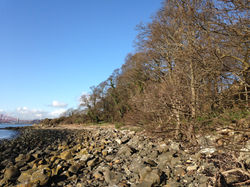Autumn Moths

When the word “moth” is mentioned, most people think immediately of holes in precious woollen clothing or carpets. But the clothes or carpet moths are but a tiny proportion of the over 2,000 moth species recorded from the UK and there are several of these moths to be found around our woodlands and gardens. Unlike their conspicuous cousins the butterflies, most moths only fly at night and so remain unseen by the majority of us. They are however of great ecological significance. The adult moths, and more especially their caterpillars, are the food for many of the small birds that we enjoy seeing visiting our gardens, as well as insect eating mammals like shrews and hedgehogs.
Thanks to an interest in the DBCWG conservation activities in our woodlands we had a visit at the end of October from Gerald Lincoln, a local wildlife and conservation enthusiast from Auchtertool. On a daytime walk round he was impressed by the range of wildflowers that we have in our area, and especially on the tops of the sea cliffs of Downing Point and the Gun Emplacement. He returned a few days later to set up some moth traps in a sheltered part of the shore edge of Hopeward Wood, and we had a chance to see some of the moths of our woodlands the following morning. Gerald has a small private wildlife reserve established a few years ago on some field adjacent to his house in Auchtertool, and he frequently examines and records the moths both in his reserve and elsewhere in Fife. He set the traps on a mild night at a location sheltered from the westerly breeze and we examined the moths in the traps the following morning.


There were about 50 individuals of around 15 species and after they were identified, a few photos were taken, albeit in rather dim light, and then they were then released. It was a little surprising to see so many different species at a time of year when most of the insect life that we typically see during daytime has all but disappeared, but there are some moth species that specialise in flying during the autumn and winter months.
Almost all moths have camouflage colouration to blend in and disruptive patterns to hide tell-tale outlines, and these allow them to rest up during daytime and, with luck, avoid the sharp eyes of the local birds such as wrens, robins and the various tits. Flying this late in the year also enables them to avoid summer insect eaters. Perhaps appropriately enough, the colours and patterns seemed to fit in with an autumnal theme. Perhaps there is material here to inspire some fashion designers in the gallery below?
















































